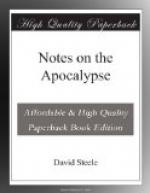The narrative of prophetic events was broken off at the end of the ninth chapter. The tenth chapter and the greater part of this, from the beginning to the thirteenth verse inclusive, present appearances and actions quite foreign to the events which follow the sounding of the trumpets. Why is this, the thoughtful student of the Apocalypse will naturally ask? Why is the regular series of the trumpets suspended? When the sixth trumpet,—the “second woe,”—has effected its objects, we naturally expect the seventh trumpet to sound; yet we are held in suspense till we come to the fourteenth verse of this chapter. Hitherto we have met with no similar interruption. Let us take a retrospective view:—The seven epistles to the churches followed each other in regular succession. The seals, in like manner, followed successively; and this is true of the vials, (ch. xvi.)
We have seen that the object of the trumpets was the Roman empire, the fourth beast of Daniel’s prophecy. The same is the object of the judgments symbolized by the vials. The final subversion and utter destruction of that beastly power, was plainly revealed in the Babylonian monarch’s dream. (Dan. ii. 44.) And the same event was afterwards exhibited in vision to Daniel, (ch. vii. 11, 26.) Now the first four trumpets had demolished imperial power in the western or Latin section; and the next two, by the Saracenic locusts and the Euphratean horsemen had subverted the eastern or Greek section. Rome and Constantinople were the capitals of the respective sections or members of the one empire. Under the first four trumpets, by the Northern barbarians; and under the first two woes, by the Mahometans, both sections of the empire were overthrown. The question now presses upon our attention, Where shall we find an object for the tremendous judgment to be inflicted by the third and last woe? This question requires a solution. It demands it; and he who succeeds in the application of history to solve this apparent enigma in the Apocalypse, will be able to attain to a satisfactory, a certain, understanding of much that is yet to most readers as if the “sealed book” were to this day in the “right hand of Him that sitteth on the throne.” Let us humbly attempt to solve this difficulty.
Daniel’s fourth beast, the Roman empire, is to be contemplated in diverse aspects, as the varied symbols obviously require. All know that Nebuchadnezzar’s “image” is the same as Daniel’s “four beasts;” therefore the same thing is presented in different forms or aspects. Of course we are to view that object as presented. We have seen that under the sixth seal, (ch. vi. 12-17,) the Roman empire underwent a revolution; that is, it was destroyed as to its Pagan form. The empire became Christian under Constantine. History proves that Christianity degenerated under the reign of that monarch and his successors. Heresy, idolatry and persecutions characterize the subsequent history




